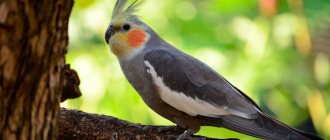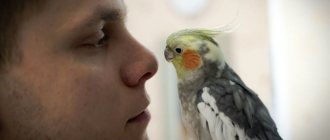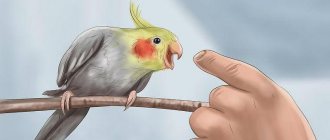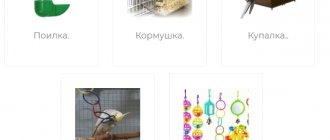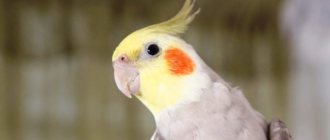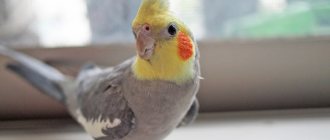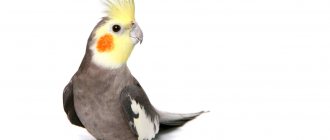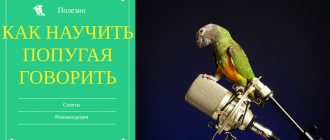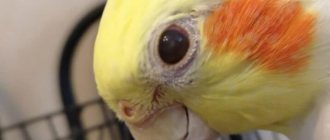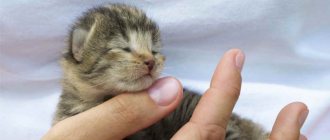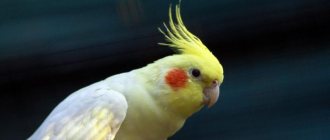How can a bird adapt to a new place?
If the cockatiel trembles and cackles in a new place, he is scared. Don't create stressful situations. He is tense and afraid of literally everything: slamming, rattling doors, barking dogs, crying children. At first, you need to take care of how to establish contact with the parrot.
First you need to create conditions that are comfortable for the bird:
- Place the cage in a quiet place.
- Protect from exposure to TV and radio.
- Restrict access to households and pets.
- Warn not to look into the cockatiel's cage unnecessarily. Approach it only to add food and change water.
- Provide the bird with everything it needs.
In this mode, the bird will spend several weeks looking closely and getting used to its new home. If possible, the same person should talk to and look after him. This way the parrot will recognize and remember its owner, in his presence it will feel protected and will not show a bad character.
Suitable diet
It is believed that the bulk of a parrot's diet comes from seeds. However, ornithologists specify that their quantity should be approximately a third of the amount of food eaten per day, since the seeds contain a lot of fat.
Special balanced food containing useful substances has been developed for cockatiels. In addition, birds happily eat natural foods such as vegetables, fruits, eggs, and beans. They can be given in small portions. Sprouted seeds can also be used as an addition to the main diet.
Communication and tactile contact
Patience, affection and attention will allow the bird to become a full-fledged member of the new family. In any situation, if it is not clear how to calm the parrot, you need to remain calm yourself. You cannot shout, hit the cage with your hand, or get irritated.
To establish contact at first, try to spend all your free time near your pet. You can talk to him affectionately, quietly sing melodic songs, treat him with fruit. This is known to always work.
If the cockatiel is trembling and clucking, you need to calm him down in a quiet, gentle voice. After a week, the bird will get used to the presence of the owner and will calmly react to his appearance. The behavior of cockatiels often depends on the situation in the house. With calm owners, the bird is also cheerful and content.
As soon as the bird stops being nervous about the presence of a person near its home, then you can try to accustom it to hands. First, they try to hand feed her, sticking her palm with food into the cage. If the parrot tries to bite, you need to remove the treat and strictly say “No,” you can gently click on the beak. Over time, he will understand that he should not do this.
At the same time, you should not wear protective gloves on your hands - they will scare away the pet even more.
Emotional impact
Being sociable birds, parrots require attention from their owners. You need to communicate with them regularly, talk, play. Otherwise, they may become depressed or aggressive.
For a bird to develop fully, it needs free flights. Corellas love to walk on the floor and sit with people on the sofa or armchair. When moving around the house, you need to be careful not to accidentally harm your pet.
How to avoid bird bites
The pet hisses and shakes when it wants to protect its home. Perhaps it is too early to accustom him to holding hands. But it’s time to ask how to properly wean timid cockatiels from biting. First of all, natural causes that cause aggressive behavior are excluded: molting, diseases, mating season. If everything is in order, the cockatiel parrot is taught to behave calmly.
What to do in this case:
- Teach to understand the “no” command by clicking on the beak or cage to attract attention.
- If the bird is ready to attack, you can distract it with a bright toy. Find out why your cockatiel is acting aggressively: he is afraid or he has negative experiences with people.
- You can spray water on it if other methods do not help.
But when you hear the cockatiel creaking its beak, rest assured: he is used to the house and is happy. Experienced poultry keepers admit: this is the best sound you can hear from a pet.
A few facts about cockatiels
At home and in the wild, cockatiels are very interesting. These birds have complex behavior and spectacular appearance.
Origin of the species
The homeland of cockatiels is Australia. They were brought to Europe in 1837 and very quickly learned to breed. The birds first arrived in Paris, and from there they spread throughout the world. The first copies appeared in Russia in 1960.
Fun facts
Cockatiel flights in Australia are an unforgettable sight. Birds create numerous flocks and perch on branches. There may be several hundred parrots on each tree.
Australia is an arid continent, but nymphs always nest near bodies of water.
In their homeland, nymphs are considered a game bird. Their meat is edible. The fact that nymphs are fearless contributes to success in hunting. Even a wild bird does not fly away when it meets a person, but flies up from the ground onto a branch and from there watches the stranger.
Despite the fact that cockatiels have long been kept as pets, breeds for apartments have not yet been bred. There are only color variations:
- albino,
- white,
- lutino (canary with scarlet pupils),
- light gray
- chestnut,
- intense yellow,
- necks (with randomly located white spots).
How to deal with loud screaming
In the wild, parrots make all sorts of loud sounds without caring about those around them. The apartment cockatiel also likes to scream, but this does not always suit the owners. When purchasing, few people take this nuance into account. Only when faced with a sharp and unpleasant cry from a pet does the owner look for a way to quickly wean the cockatiel bird from screaming.
There are several effective ways to cope with screaming:
- Buy him a pair. Together, the birds feel more confident, they have no time to be bored, they are busy with each other.
- Play melodious music quietly. This calms Corella down. He even dances.
- Corella yells if people yell at him. He is a good imitator, so you need to speak to him quietly and gently.
- Check the feeder and drinker. Perhaps the bird is just hungry, and everyone is only concerned with how to stop it from screaming.
- In the evening, you can simply send a wild cockatiel to bed by turning off the light.
By this, the owner demonstrates that the household does not intend to listen to wild screams. Over time, the pet will understand that this is not worth doing.
Cleaning the cage
Corella parrots are very active and playful, they love to climb rods and perches. They need fairly spacious houses. To keep one bird, you must purchase a horizontal cage, the dimensions of which are at least 50x50x65 cm.
The bird's home and all the equipment in it must be cleaned periodically to prevent fungi or mold from appearing in it. It is recommended to do this twice a week, with warm water. It is necessary to remove food debris and droppings. The tray can be filled with fine sand or covered with paper.
Bird behavior depends on productive sleep
Excitability is directly related to how long the harmful cockatiel sleeps. For normal functioning, he needs 10 hours of quiet, deep sleep.
When a cockatiel sleeps, the following rules should be observed:
- Turn off the radio and TV during daytime naps.
- Cover your pet's cage while sleeping at night to prevent light and sounds from waking him up.
- Protect the bird from harsh sounds.
If the bird gets a full 10-hour sleep, you won’t have to wonder why the parrot is lethargic or excitable in the morning.
Age: adult bird or chick
Cockatiels are cheerful and cheerful companions. They are very smart and easily learn to speak, perform tricks and simple requests.
The age at which a parrot learns best
As I already mentioned, it would be best to bring home a young chick, who will quickly accept the new environment and make friends with the owner. But the opportunity to adopt a chick is not always given.
Already from the age of one year, parrots find it difficult to perceive innovations and changes in life. Interaction with the bird must be carefully established.
The ways to make friends with a young or adult nymph are not particularly different.
But remember! Those who lived in a pack of their own kind find it difficult to tame. In this case, they prefer communication with their fellow tribesmen rather than with humans.
If there are children in the house
Kids rejoice at the appearance of a colorful pet in the house, but there are a number of rules that parents should teach their children. It is important to properly arrange a home where there are birds and a small child.
To avoid any troubles, children are explained what they should absolutely not do:
- Screaming near the cage. Tell your child why the parrot is afraid of sharp sounds.
- Play with the bird like a toy: flapping, pulling out feathers, strangling.
- Open the cage without adult permission. Explain that the bird flies well and can slip out of the open window.
- You can't have a cockatiel and your small child living in the same room.
Also, parents should show by their own example how to calm excited cockatiels and how to care for them. You can train the bird together and show your child in a playful way how to wean the bird from being afraid of people.
Optimal climate
Brightly colored cockatiels spread around the world from the Australian continent. The main features of the climate in this area are high air temperatures and humidity. When keeping Corella parrots at home, it is necessary to create conditions similar to natural ones. In the room where the cage is installed, the air temperature should be maintained at 20–25 degrees and humidity at 60–70%.
In addition to air temperature and humidity, illumination is important. During the warm season, cockatiels love to sunbathe. Therefore, cages with pets can be taken out onto the balcony. The cage should be slightly shaded so that the bird does not get burned from direct sunlight. The duration of solar procedures should be limited to 30 minutes. To create artificial lighting, you can install an ultraviolet lamp at a distance of more than 50 cm from the parrot’s home. If proper care for your cockatiel parrot is neglected, your pet may develop health problems.
If the parrot flies away
A bird owner may leave a window or door open and not notice the cockatiel flying away. We need to try to get him back. You need to understand that the pet is not far away. He, scared and confused, hides in a tree in the yard.
To attract the attention of a fugitive, do the following:
- Play a recording of the chirping of parrots of his species or melodious music on the windowsill.
- They place a feeder with his favorite food on the window.
- If there are other birds in the house, take them outside in a cage.
- You need to walk along the nearest streets and call your pet. Perhaps he will respond.
Not always, if a cockatiel parrot has flown away, it is useless to look for it. But the likelihood that, under the influence of hunger, he will find his way to another house is high. The death of the bird is not excluded.
Winning the heart of a cockatiel is not difficult if you work at it every day. The main tool for creating a friendly relationship with your pet is love and patience. Over time, the nimble bird will become a full member of the family. Her sweet talk and awkward dances will not let you get bored even on the gloomiest days. And remember: let your cockatiel squeak his beak more often.
Mistakes you shouldn't make
It is unacceptable to do anything that is perceived negatively by the nymph and violates the trusting relationship between her and her owner.
- You cannot perform actions against the will of the cockatiel, so that he does not expect constant trickery from his owner.
- It is not advisable to entrust the care of the parrot to another person during the training period, because a bird should have only one owner.
- The nymph has a well-developed metabolism, so you cannot raise a cockatiel by going on a hunger strike - this is fraught with unpleasant consequences for the health of the bird.
- Training a parrot if it is in a bad mood or unwell will be ineffective.
How do supporters of a positive solution explain their position?
- Compliance with daylight rules.
- Preventing unexpected egg laying.
- Normalization of hormonal balance.
Read also
How to determine the age of a budgerigar
There are arguments that the bird’s sleep and wakefulness patterns can be instilled according to one’s own calculations, ignoring their natural predisposition to a much more complex routine. This can also contribute to success in taming the noisy troublemaker and subordinating it to its owner. To put it mildly, it will increase discipline.
Beak care
Thanks to its beak, the cockatiel can grind food, climb the walls of the cage, and clean feathers. The young parrot has a smooth short beak with no signs of damage. With age, the stratum corneum of the beak begins to grow, interfering with its functions. To make it easier for the bird to grind off the excess part, you need to put sepia, branches of fruit trees, and mineral stones in the cage.
If the beak has grown too much, it needs to be trimmed. To do this, cut off several small parts of the stratum corneum. Use nail scissors that have been previously disinfected in alcohol.
Do everything slowly and carefully so as not to damage the blood capillary inside the beak. If you accidentally hit it, pour hydrogen peroxide on the wound. After trimming, treat the cut area with a nail file moistened with alcohol. This way you can even out possible unevenness.
Sometimes the cockatiel's beak begins to peel off. There are several reasons for this phenomenon:
- lack of vitamins and minerals in the bird’s body,
- molting,
- stress,
- scabies mites (knemidocoptic mange),
- liver or kidney diseases,
- injuries,
- hormonal imbalances.
To help your parrot, add sprouted millet or wheat grains, feed yeast, calcium gluconate (one tablet per day), crushed chalk and eggshells to the bird's diet. If nothing helps your cockatiel, contact your veterinarian for advice. Your pet may have a serious illness. In this case, only a doctor can make a diagnosis and prescribe treatment.
